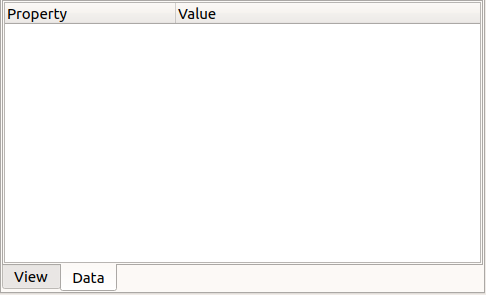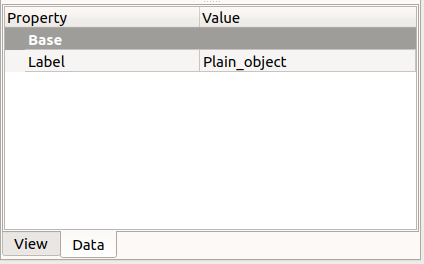Property editor
Introduction
The property editor appears when the Model tab of the combo view is active in the interface; it allows managing the publicly exposed properties of the objects in the document.
Generally, the property editor is intended to deal with just one object at one time. The values shown in the property editor belong to the selected object of the active document. Despite this, some properties like colors, can be set for multiple selected objects. If there are no elements selected, the property editor will be empty.
Not all properties can be modified always; depending on the specific status of the property, some of them will be invisible (not listed), or be read-only (not editable).
Empty property editor, when no object is selected.
Property types
A property is a piece of information like a number or a text string that is attached to a LabRPS document or an object in the document.
Custom scripted objects can use any of the property types defined in the base system. See the full list in Property.
Some of the most commonly used property types are:
App::PropertyBool App::PropertyFloat App::PropertyAngle App::PropertyDistance App::PropertyInteger App::PropertyString App::PropertyMatrix App::PropertyVector App::PropertyPlacement
Different objects may have different types of properties. However, many objects have the same types because they are derived from the same internal class. For example, most objects that describe geometrical shapes (lines, circles, rectangles, solid bodies, imported parts, etc.), have the "Placement" property that defines their position in the 3D view.
View and Data properties
There are two classes of feature properties accessible through tabs in the property editor:
- View properties, related to the "visual" appearance of the object. The View properties are tied to the ViewProvider (
ViewObjectattribute) of the object, and are only accessible when the graphical user interface (GUI) is loaded. They are not accessible when using LabRPS in console mode, or as a headless library. - Data properties, related to the "physical" parameters of the object. The Data properties define the essential characteristics of the object; they exist at all times, even when LabRPS is used in console mode, or as a library. This means that if you load a document in console mode, you can edit the radius of a circle or the length of a line, even if you cannot see the result on the screen.
For this reason, Data properties are considered to be more "real", as they truly define the geometry of a shape. On the other hand, View properties are less important because they only affect the superficial appearance of the geometry. For example, a circle of 10 mm radius is different from a circle of 5 mm radius; the color of the circle (view property) doesn't affect its shape, but the radius does (data property). In many instances in this documentation, the word "property" is understood to refer to a "Data property" and not to a "View property".
Basic properties
See also: Object name
The most basic scripted object won't show any Data property in the property editor, except for its Label attribute. The Label is a user editable string that identifies the object in the tree view. On the other hand, the Name attribute of an object is assigned at the moment of its creation and cannot be changed; this attribute is read-only, and is not displayed in the property editor either.
A basic parametric object is created as follow
obj = App.ActiveDocument.addObject("App::FeaturePython", "App__FeaturePython")
obj.Label = "Plain_object"
print(obj.Name)
print(obj.Label)
View and Data tabs of the property editor, for a basic "App::FeaturePython" scripted object.
Most geometrical objects that can be created and displayed in the 3D view are derived from a Part::Feature. See Part Feature for the most basic properties that these objects have.
For 2D geometry, most objects are derived from Part::Part2DObject (itself derived from Part::Feature) which is the base of Sketches, and most Draft elements. See Part Part2DObject for the most basic properties that these objects have.
Actions
Right clicking in an empty space of the view, or with a property selected, shows only one command:
- Show all: if active, in addition to the standard properties that appear already, it shows all the hidden Data and View properties in their respective tabs.
- Data: "Proxy", "Label2", "Expression Engine", and "Visibility".
- View: "Proxy".
When the Show all option is active, and one property is selected, more actions are available with a second right click:
- Show all: deactivates the Show all command, hiding the additional Data and View properties.
- Add Property: adds a dynamic property to the object; this works with both C++ defined objects, and Python scripted objects.
- Expression...: brings up the formula editor, which allows using expressions in the property value.
- Hidden: if active, sets the property as hidden, meaning that it will only be displayed in the property editor if Show all is active.
- Output: if active, sets the property as output.
- NoRecompute: if active, sets the property as not recomputed when the document is recomputed; this is useful when a property should be kept unaffected by other updates.
- ReadOnly: if active, sets the property to be read-only; it won't be editable in the property editor any more until this switch is turned off. The Expression... menu entry is no longer available. Note: It may be still possible to change the property via a dialog that updates the property.
- Transient: if active, sets the property as transient. The value of a transient property is not saved to file. When opening a file, it is instantiated with its default value.
- Touched: if active, it becomes touched, and ready for recompute.
- EvalOnRestore: if active, it is evaluated when the document is restored.
Example of the properties of a PartDesign object
In this section we show some common properties that are visible for a PartDesign Body, and one PartDesign Feature. The specific properties of an object can found in the specific documentation page of that object.
View
Most of these properties are inherited from the Part Feature basic object.
Base
- ViewAngular Deflection: it is another way to specify how finely to generate the mesh for rendering on screen or when exporting. The default value is 28.5 degrees, or 0.5 radians. The smaller the value the smoother the appearance will be in the 3D view, and the finer the mesh that will be exported.
- ViewBounding Box: indicates if a box showing the overall extent of the object is displayed.
- ViewDeviation: sets the accuracy of the polygonal representation of the model in the 3D view (tessellation). Lower values indicate better quality. The value is in percent of object's size.
- ViewDisplay Mode: display mode of the entire Body,
Flat lines(default),Shaded,Wireframe,Points. - ViewDisplay Mode Body: display mode of the Tip of the Body,
Through(default),Tip. - ViewDraw Style:
Solid,Dashed,Dotted,Dashdot; defines the style of the edges in the 3D view. - ViewLighting:
One side,Two side(default). - ViewLine Color: the RGB color of the edges, it defaults to
(25, 25, 25). - ViewLine Width: the thickness of the edges, it defaults to
2pixels. - ViewOn Top When Selected:
Disabled,Enabled,Object,Element. - ViewPoint Color: the RGB color of the vertices, it defaults to
(25, 25, 25). - ViewPoint Size: the size of the vertices, it defaults to
2pixels. - ViewSelectable: whether the object is selectable or not.
- ViewSelection Style:
Shape,BoundBox. - ViewShape Color: the RGB color of the shape, it defaults to
(204, 204, 204). - ViewShow In Tree: if it is
true, the object appears in the tree view. Otherwise, it is set as invisible. - ViewTransparency: the degree of transparency from
0(default) to100. - ViewVisibility: whether the object is visible in the 3D view or not. Toggle with the Space bar in the keyboard.
Data
In this case we observe the properties of the PartDesign Revolution feature.
Base
- DataLabel: the user defined name given to the object, this can be changed as desired.
Part Design
- DataRefine: whether to refine the fusion done with other objects.
Revolution
- DataBase: the point in space that specifies where the revolution takes place. It cannot be modified directly, only when editing the feature.
- DataAxis: the axis around which the revolution will be performed. It cannot be modified directly, only when editing the feature.
- DataAngle: the angle that specifies how much of the base element is rotated. By default it is
360 deg, but it can be any fraction of that.
Sketch Based
- DataMidplane: if the base object is a Sketch, when this property is
true, it will perform the revolution with the sketch serving as a plane of symmetry. This is noticeable if the DataAngle is different from360 deg. - DataReversed: by default it is
true. Whether to perform the revolution in one direction or the other.
Scripting
See also: LabRPS Scripting Basics.
See scripted objects for the full information on adding properties to objects defined through Python.
Most properties that are visible in the property editor can be accessed from the Python console. These properties are just attributes of the class that defines the selected object. For example, if the property editor shows the DataGroup property, this means that the object has the Group attribute.
print(obj.Group)
These attributes (properties) are added with the addProperty method of the base object. At least it is necessary to specify the type of property, and its name.
obj.addProperty("App::PropertyFloat", "Custom")
print(obj.Custom)
Properties follow the CapitalCamelCase or PascalCase convention, meaning that each word starts with a capital letter, and there are no underscores. When the property editor displays such names, it leaves a space between each capital letter, making it easier to read.
obj.addProperty("App::PropertyDistance", "CustomCamelProperty")
obj.CustomCamelProperty = 1000
print(obj.CustomCamelProperty)
File:LabRPS Property editor Custom.png
Property editor showing the Data properties of a PartDesign Body, with two additional properties, "Custom" and "Custom Camel Property".
In similar way the View properties are added, not to the base object, but to its ViewObject. Then, it follows that properties like ViewAngular Deflection, ViewBounding Box, ViewDisplay Mode, ViewDisplay Mode Body, ViewLine Color, and others, can be examined and changed from the Python console.
print(obj.ViewObject.AngularDeflection) print(obj.ViewObject.BoundingBox) print(obj.ViewObject.DisplayMode) print(obj.ViewObject.DisplayModeBody) print(obj.ViewObject.LineColor)
All public properties of the object, and of its view provider, are contained in the corresponding PropertiesList attribute.
print(obj.PropertiesList) print(obj.ViewObject.PropertiesList)
{{Interface navi{{#translation:}}}} {{Std Base navi{{#translation:}}}} {{Userdocnavi{{#translation:}}}}


